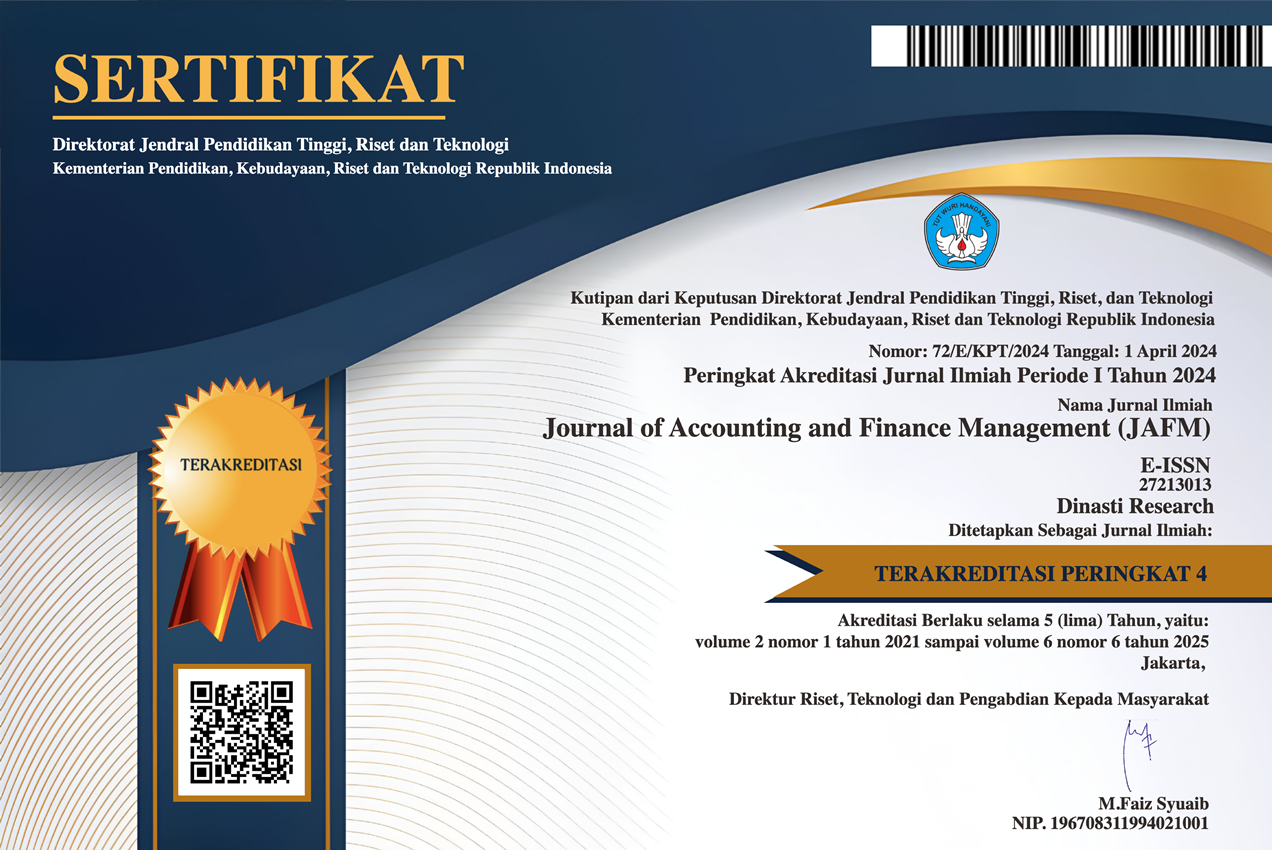Model Evaluation and Implementation Strategy Planning Based on Attrition Predictive Model in Perseroan Luar Negeri Ltd
DOI:
https://doi.org/10.38035/jafm.v6i3.2252Keywords:
Employee Attrition, Machine Learning, Online Model Evaluation, Retention Strategy, HR Analytics.Abstract
Over the past three years, Perseroan Luar Negeri Ltd.’s five Singapore-based subsidiaries have experienced a consistent increase in attrition rates above annual average benchmarks, raising concerns about service continuity, increased rehiring and onboarding costs, and weakened customer relationships. To address this, the Group implemented machine-learning models designed to potential leavers six months in advance. This research evaluates the first full year of the model's deployment and proposes integrating predictive insights into HR decision-making. The evaluation includes both offline assessments (precision-recall screening of six algorithms during production) and an online evaluation using Wilson-scored recall/precision, Popular-Stability-Index for covariate drift, Linear Four Rate for concept drift, and two business KPIs: voluntary turnover delta and retention yields. Findings shows that only recall-focused models met business targets. Covariate drift, likely triggered by performance-rating freezes and mandated training, caused significant recall deterioration, whereas concept-drift tests remained negative, validating algorithm logic. To address these issues, the study proposes short-term solutions through model retraining. Mid-term actions include conducting exit-interview analyses, redefining attrition baselines, developing quality-control dashboards, establishing comparative benchmarks, and adjusting voluntary turnover calculations to highlight hidden successes during market volatility using industry attrition projections and sector-engagement indices. For long-term sustainability, the study recommends comprehensive training and documentation programs to establish robust talent-risk governance.
References
Abd Alia, Z. N., & Alhamad, A. M. (2022). Behavior financial theory and analysis of investor behavior in the capital markets in Lebanon. Journal of Management and Economic Studies, 4(2), 82–90. https://doi.org/10.26677/TR1010.2022.1014
Adrjan, P., & Lydon, R. (2019, October). Labour market tightness and wages: Evidence from online job postings. Paper presented at the IZA Conference on Big Data in Labor Economics, Bonn, Germany.
Al Mamun, C. A., & Hasan, M. N. (2017). Factors affecting employee turnover and sound retention strategies in business organization: A conceptual view. Problems and Perspectives in Management, 15(1), 63–71. https://doi.org/10.21511/ppm.15(1).2017.06
Al-Suraihi, W. A., Samikon, S. A., Al-Suraihi, A.-H. A., & Ibrahim, I. (2021). Employee turnover: Causes, importance and retention strategies. European Journal of Business and Management Research, 6(3), 1–10. https://doi.org/10.24018/ejbmr.2021.6.3.893
Ambrosat, S., & Grünwald, C. (2023). Towards a future-proof organisation: Using foresight in HR and organisational development. Strategic HR Review, 22(5), 169–173. https://doi.org/10.1108/SHR-07-2023-0040
Baylor, D., Brecht, L., Casagrande, N., et al. (2017). TFX: A TensorFlow based production scale machine learning platform. In Proceedings of the 23rd ACM SIGKDD International Conference on Knowledge Discovery and Data Mining (pp. 1387 1395).
Belete, A. K. (2018). Turnover intention influencing factors of employees: An empirical work review. Journal of Entrepreneurship & Organization Management, 7(3), 253–267. https://doi.org/10.4172/2169-026X.1000253
Branham, L. (2005). The 7 hidden reasons employees leave: How to recognize the subtle signs and act before it's too late. AMACOM.
Brown, L. D., Cai, T. T., & DasGupta, A. (2001). Interval estimation for a binomial proportion. Statistical Science, 16(2), 101–117. https://doi.org/10.1214/ss/1009213286
Carter, S. P., Dudley, W., Lyle, D. S., & Smith, J. Z. (2019). Who’s the boss? The effect of strong leadership on employee turnover. Journal of Economic Behavior & Organization, 159, 323–343. https://doi.org/10.1016/j.jebo.2018.12.028
Caruana, R., & Niculescu Mizil, A. (2006). An empirical comparison of supervised learning algorithms. In Proceedings of the 23rd International Conference on Machine Learning (pp. 161 168). https://doi.org/10.1145/1143844.1143865
Cascio, W. F. (2014). Leveraging employer branding, performance management, and human resource development to enhance employee retention. Human Resource Development International, 17(2), 121–128. https://doi.org/10.1080/13678868.2014.886443
Clark, K. A., & Hyson, R. (2000). Measuring the demand for labor in the United States: The Job Openings and Labor Turnover Survey. In Proceedings of the American Statistical Association, Survey Research Methods Section (pp. 251–256).
Davis, S. J., Faberman, R. J., & Haltiwanger, J. C. (2012). Labor market flows in the cross section and over time. Journal of Monetary Economics, 59(1), 1–18.
El-Rayes, N., Fang, M., Smith, M., & Taylor, S. (2020). Predicting employee attrition using tree-based models. International Journal of Organizational Analysis, 28(6), 1273–1291. https://doi.org/10.1108/IJOA-10-2019-1903
Gama, J., Sebastião, R., & Rodrigues, P. P. (2013). On evaluating stream learning algorithms. Machine Learning, 90(3), 181–213.
Gama, J., Žliobait?, I., Bifet, A., Pechenizkiy, M., & Bouchachia, A. (2014). A survey on concept drift adaptation. ACM Computing Surveys, 46(4), Article 44. https://doi.org/10.1145/2523813
Gómez Uribe, C. A., & Hunt, N. (2015). The Netflix recommender system: Algorithms, business value, and innovation. ACM Transactions on Management Information Systems, 6(4), Article 13.
Guerry, M., & De Feyter, T. (2009). Markovian approaches in modeling workforce systems. Journal of Current Issues in Finance, Business and Economics, 2(4), 351–370.
Hakanen, J. J., Ropponen, A., Schaufeli, W. B., & De Witte, H. (2019). Who is engaged at work? A large-scale study in 30 European countries. Journal of Occupational and Environmental Medicine, 61(11), 877–886.
Holtom, B. C., Mitchell, T. R., Lee, T. W., & Eberly, M. B. (2008). Turnover and retention research: A glance at the past, a closer review of the present, and a venture into the future. The Academy of Management Annals, 2(1), 231–274. https://doi.org/10.1080/19416520802211552
Hossain, M. S., Hossain, M. R., Hasan, S. M. M., Akter, F., Srizon, A. Y., Farukuzzaman, M., & Islam, H. (2023). Leveraging AI-driven strategies to mitigate employee turnover in commercial industries. In Proceedings of the 2023 26th International Conference on Computer and Information Technology (ICCIT), Cox's Bazar, Bangladesh. https://doi.org/10.1109/ICCIT60459.2023.10441379
Hur, H., & Hawley, J. (2019). Turnover behavior among US government employees. International Review of Administrative Sciences, 86(4), 641–656. https://doi.org/10.1177/0020852318823913
Kahn, W. A. (1990). Psychological conditions of personal engagement and disengagement at work. Academy of Management Journal, 33(4), 692–724.
Kaplan, R.S. and Norton, D.P. (1996) Strategic Learning: The Balanced Scorecard. Strategy & Leadership, 24, 18-24.
https://doi.org/10.1108/eb054566
Kaur, P., Malhotra, K., & Sharma, S. K. (2020). Moderation-mediation framework connecting internal branding, affective commitment, employee engagement and job satisfaction: An empirical study of BPO employees in Indian context. Asia-Pacific Journal of Business Administration, 12(3/4), 327–348. https://doi.org/10.1108/apjba-10-2019-0217
Kearns, P. (2003). HR strategy: Business focused, individually centred. Butterworth-Heinemann.
Kott, P. S. (2017). A note on Wilson coverage intervals for proportions estimated from complex samples. Survey Methodology, Statistics Canada, 43(2). http://www.statcan.gc.ca/pub/12-001-x/2017002/article/54872-eng.htm
Lai-Bennejean, C., & Beitelspacher, L. (2021). Impacts of salespeople’s biased and unbiased performance attributions on job satisfaction: The concept of misattributed satisfaction. European Journal of Marketing, 55(2), 468–496. https://doi.org/10.1108/ejm-11-2018-0816
Lu, J., Liu, A., Dong, F., Gu, F., Gama, J., & Zhang, G. (2019). Learning under concept drift: A review. IEEE Transactions on Knowledge and Data Engineering, 31(12), 2346–2363.
Lundberg, S. M., & Lee, S.-I. (2017). A unified approach to interpreting model predictions. In Advances in Neural Information Processing Systems (Vol. 30).
March, J. G., & Simon, H. A. (1958). Organizations. John Wiley & Sons.
Mohammad, I., & Jahangir, A. (2014). Factors influencing intention to quit or stay in jobs: An empirical study on selected sectors in Bangladesh. Stamford Journal of Business Studies, 6(1), 142–164. https://www.researchgate.net/publication/292963289
Nandal, M., Grover, V., Sahu, D., & Dogra, M. (2024). Employee attrition: Analysis of data-driven models. EAI Endorsed Transactions on Internet of Things, 10(1). https://doi.org/10.4108/eai.28-1-2024.172902
Orawo, L. A. (2021). Confidence intervals for the binomial proportion: A comparison of four methods. Open Journal of Statistics, 11(5), 806–816.
Park, T. Y., & Shaw, J. D. (2013). Turnover rates and organizational performance: A meta-analysis. Journal of Applied Psychology, 98(2), 268–309. https://doi.org/10.1037/a0030723
Pukelsheim, F. (1994). The Three Sigma Rule. The American Statistician, 48(2), 88–91. https://doi.org/10.2307/2684253
Rigamonti, E., Gastaldi, L., & Corso, M. (2023). Measuring HR analytics maturity: Supporting the development of a roadmap for data-driven human resources management. Management Decision, 62(13), 243–282. https://doi.org/10.1108/MD-11-2023-2087
Schaufeli, W. B., & Bakker, A. B. (2004). Job demands, job resources, and their relationship with burnout and engagement: A multi-sample study. Journal of Organizational Behavior, 25(3), 293–315.
Schaufeli, W. B., Shimazu, A., Hakanen, J. J., Salanova, M., & De Witte, H. (2019). An ultra-short measure for work engagement: The UWES-3 validation across five countries. European Journal of Psychological Assessment, 35(4), 577–591.
Schlechter, A. F., Syce, C., & Bussin, M. (2016). Predicting voluntary turnover in employees using demographic characteristics: A South African case study. Acta Commercii, 16(1), Article 274. https://doi.org/10.4102/ac.v16i1.274
Schröer, C., Kruse, F., & Gómez, J. M. (2021). A systematic literature review on applying CRISP-DM process model. Procedia Computer Science, 181, 526–534. https://doi.org/10.1016/j.procs.2021.01.199
Sculley, D., Phillips, T., Ebner, D., Chaudhary, V., Young, M., Crespo, J.-F., & Dennison, D. (2015). Hidden technical debt in machine learning systems. Advances in Neural Information Processing Systems, 28, 2503–2511.
Sharma, A. (2018). Confusion matrix in machine learning. GeeksforGeeks. https://www.geeksforgeeks.org/confusion-matrix-in-machine-learning/
Shenoy, N. (2016). Employee turnover – impact on organizations and reasons. International Journal of Advanced Research in Management, 7(1), 96–104.
Siddiqi, N. (2006). Credit risk scorecards: Developing and implementing intelligent credit scoring. Wiley.
Singh, K., & Singh, R. (2019). A study on employee attrition: Effects and causes. Journal of Research in Engineering, Science and Management, 2(8), 174–178.
Thakur, P. (2020). A chronological review of human resource management. Journal of Emerging Technologies and Innovative Research, 7(2), 537–541.
Widmer, G., & Kubat, M. (1996). Learning in the presence of concept drift and hidden contexts. Machine Learning, 23(1), 69–101. https://doi.org/10.1007/BF00116900
Xu, H., Ho, Q., & Kumar, A. (2020). Model performance management at LinkedIn. IEEE Data Engineering Bulletin, 43(2), 40–51.
Yurdakul, B., & Naranjo, B. (2020). Statistical properties of the population stability index. Journal of Risk Model Validation. https://doi.org/10.21314/JRMV.2020.227
Zheng, A. (2015). Evaluating machine learning models: A beginner’s guide to key concepts and pitfalls. O’Reilly Media.
Downloads
Published
How to Cite
Issue
Section
License
Copyright (c) 2025 Gland Wialldi, Hary Febriansyah

This work is licensed under a Creative Commons Attribution 4.0 International License.
Authors who publish their manuscripts in this journal agree to the following conditions:
- The copyright on each article belongs to the author(s).
- The author acknowledges that the Journal of Accounting and Finance Management (JAFM) has the right to be the first to publish with a Creative Commons Attribution 4.0 International license (Attribution 4.0 International (CC BY 4.0).
- Authors can submit articles separately, arrange for the non-exclusive distribution of manuscripts that have been published in this journal into other versions (e.g., sent to the author's institutional repository, publication into books, etc.), by acknowledging that the manuscript has been published for the first time in the Journal of Accounting and Finance Management (JAFM).
























